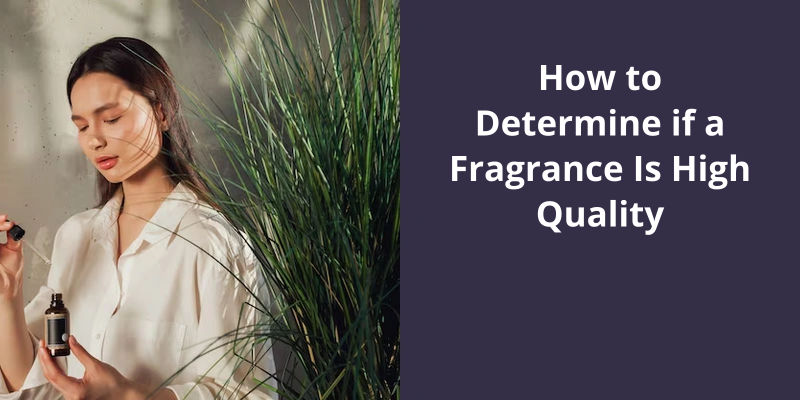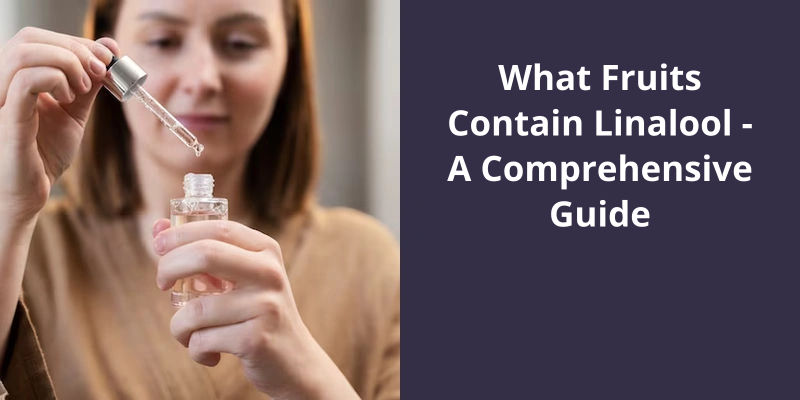In the world of fragrances, determining whether a scent is of high quality can be a nuanced task. One indication of a top-notch fragrance lies in it’s complexity. High-quality perfumes are known for their ability to layer different notes, producing a multidimensional scent that evolves over time. These layered scents create a symphony of fragrant harmonies, captivating the senses and leaving a lasting impression. Additionally, high-quality fragrances boast versatility, effortlessly transitioning from day to night, season to season, and occasion to occasion. The ability to adapt and enhance one's personality is a hallmark of a well-crafted fragrance. Moreover, base notes play a vital role in determining the quality of a perfume. These lingering scents provide the final touch, ensuring that the fragrance lingers on the skin even after the initial top and middle notes have dissipated.

How Do You Characterize Perfume?
When it comes to determining whether a fragrance is of high quality, one of the key factors to consider is how it’s characterized. Perfumers often describe the composition of a perfume using a fragrance triangle, also known as a scent pyramid. This triangle is divided into three sections: top, heart, and base notes. Each section represents different ingredients used in the fragrance, categorized according to their volatility and perception.
The top notes of a perfume are the most volatile and give the initial impression when you first smell it. These are typically light, refreshing, and evaporate quickly. They create the first olfactory impact and are often citrusy or aromatic. Common top notes include bergamot, lemon, lavender, or green leaves.
Moving down the fragrance triangle, we reach the heart notes. These are the middle notes that are present once the top notes have dissipated. Heart notes add depth and complexity to the fragrance, creating the main theme or character of the scent. They harmonize with the top notes and can last for several hours. Floral and fruity scents such as rose, jasmine, or berries are often found in the heart notes.
At the base of the fragrance triangle, we find the base notes. These are the least volatile and provide the foundation and staying power of the perfume. Base notes emerge over time, often several hours after application, and can linger on the skin for hours or even days. Ingredients such as musk, amber, vanilla, or woods are commonly used as base notes to give the fragrance longevity and a sense of depth.
A high-quality perfume will have a well-balanced fragrance triangle, with each section seamlessly transitioning into the next. The top notes should create an appealing first impression, the heart notes should be captivating and harmonious, and the base notes should provide a long-lasting, memorable finish.
Additionally, the concentration of essential oils in the perfume can also indicate it’s quality. Generally, higher concentrations of oils, referred to as parfum or extract, indicate a richer and more complex fragrance. On the other hand, eau de toilette or eau de parfum may have a lighter scent and shorter longevity.
Testing it on your skin and allowing it to develop over time will give you a better understanding of it’s character and how it evolves. Ultimately, a high-quality fragrance should leave a lasting impression and bring you joy every time you wear it.
Perfume Collecting as a Hobby or Investment.
- Research different perfume brands
- Attend perfume collectors’ events
- Join online perfume collecting communities
- Learn about fragrance notes and compositions
- Keep track of perfume release dates
- Invest in limited edition or discontinued perfumes
- Properly store and display your perfume collection
- Consider investing in vintage or niche perfumes
- Stay updated with perfume market trends
- Connect with experienced perfume collectors
When it comes to finding the perfect perfume or cologne, it’s crucial to understand your own personal preferences. Knowing the types of scents you enjoy will guide you towards the right fragrance. Remember not to overwhelm yourself by smelling too many perfumes in one go, as this can confuse your senses. Instead, take your time and test them on your skin to see how they react with your body chemistry. And if you’re still unsure, consider purchasing perfume samples to try out before committing to a full-sized bottle.
How Do I Know What Perfume Suits My Body?
When it comes to determining the right perfume for your body, understanding your taste is crucial. Before you embark on your fragrance shopping journey, take some time to explore and identify the types of scents that appeal to you. Think about the aromas that make you feel comfortable, confident, or happy. Understanding your preferences will help narrow down the options and make the selection process easier.
While it can be tempting to sniff multiple scents at once to expedite the decision-making process, it’s best to resist this urge. Smelling too many fragrances simultaneously can overwhelm your olfactory senses and distort your ability to distinguish between scents accurately. Instead, take your time and focus on one fragrance at a time. Inhale and allow the aroma to settle before moving on to the next option.
Testing perfumes on your skin is a crucial step in finding the perfect fragrance match. Our skin chemistry varies from person to person, making it essential to assess how a perfume interacts with your bodys natural scent. Apply a small amount of the fragrance to your skin and let it develop for a few hours. This will allow you to evaluate how the notes evolve and blend with your unique body chemistry.
To explore a wide variety of fragrances without committing to full-sized bottles, consider purchasing perfume samples. Many fragrance brands offer sample sizes or discovery sets, allowing you to try several perfumes before making a final decision. Sampling different scents will give you a better understanding of how they interact with your bodys chemistry and help you determine which perfumes are truly high quality and suited to your tastes.
In addition to considering the fragrance itself, it’s important to pay attention to the quality of the perfume. High-quality fragrances are crafted with top-notch ingredients and undergo meticulous production processes, resulting in fragrances that are long-lasting and well-balanced. Look for reputable perfume brands known for their dedication to quality and craftsmanship. Take note of the perfumes longevity on your skin and how the notes unfold over time. A high-quality fragrance will showcase depth, complexity, and a seamless blending of the different scent components.
The fragrance concentration refers to the strength that a fragrance has, which can vary depending on the brand and type of perfume. This is important information for consumers as it helps them determine the intensity of the scent and how long it will last. By understanding the different fragrance concentrations, one can make a more informed decision when choosing a perfume that suits their preference and desired level of fragrance.
How Can You Tell How Strong a Fragrance Is?
It’s an important factor to consider when determining the quality of a fragrance. The fragrance concentration determines how long the scent will last on the skin and how potent it will be.
Typically, fragrances are available in four main concentrations: parfum, eau de parfum, eau de toilette, and eau de cologne. Parfum has the highest concentration and is therefore the strongest and longest-lasting. It usually contains 15-30% fragrance oil and can last up to 12 hours on the skin.
Eau de parfum has a slightly lower concentration, usually ranging from 10-20% fragrance oil. It still provides a strong scent but may not last as long as parfum. Eau de toilette has a lower concentration, typically around 5-15%, and is lighter and more suitable for daytime wear. It may last for a few hours before needing to be reapplied.
Eau de cologne has the lowest concentration, ranging from 2-4%. It’s the lightest and most refreshing option, perfect for hot summer days but may only last for an hour or two. The concentration of a fragrance can also affect it’s price.
One of the key factors is the complexity and depth of the scent. A high-quality fragrance will often have multiple layers and notes, blending harmoniously to create a unique and captivating aroma. The longevity of the scent is also a sign of quality. A fragrance that lasts throughout the day without needing constant reapplication indicates a well-crafted formulation.
Furthermore, a high-quality fragrance will have a well-balanced projection. It should neither be too overpowering nor too weak, but rather have a balanced and pleasing presence in the air around you. Additionally, the ingredients used in the fragrance can also reveal it’s quality. Look for fragrances that use high-quality raw materials and natural extracts, as they tend to have a richer and more authentic aroma. Lastly, reputable fragrance brands with a long-standing history often have a reputation for producing high-quality scents, as they’ve the expertise and experience to create exceptional fragrances.
How long will the perfume’s fragrance last on your skin? A high-quality perfume should have good longevity, meaning it will stay on your skin and continue to emit it’s scent for a significant amount of time. These two factors, sillage and longevity, are essential in determining the quality of a perfume and should be taken into account when selecting a fragrance.
How Can You Tell if a Perfume Is Good Quality?
A high-quality perfume will have a long-lasting scent that lingers on the skin throughout the day. Fragrances that fade away quickly may be a sign of poor quality or diluted ingredients. To determine the longevity, spray the perfume on your skin and observe how long it retains it’s scent. If the fragrance continues to linger for hours, it’s likely of good quality.
Another indicator of a high-quality perfume is the complexity of it’s scent. A well-crafted fragrance will have multiple layers, with different notes evolving over time. This complexity adds depth and character to the perfume, creating a more nuanced and sophisticated olfactory experience. On the other hand, a cheap perfume may have a simple, one-dimensional scent that lacks depth and complexity.
The ingredients used in a perfume also play a crucial role in determining it’s quality. High-quality perfumes often use natural, high-grade ingredients sourced from reputable suppliers. These ingredients can be expensive, but they offer a richness and authenticity that synthetic alternatives can’t replicate. Cheaper perfumes, on the other hand, may rely heavily on synthetic ingredients that lack the same depth and complexity.
A high-quality fragrance will typically come in a well-designed bottle with attention to detail. The packaging should feel sturdy and luxurious, reflecting the care and craftsmanship that went into creating the perfume.
Lastly, the reputation and reviews of a perfume brand can also be helpful in determining it’s quality. Established perfume houses with a long history of producing exceptional fragrances are more likely to deliver high-quality products.
Perfume Composition and Note Classification: Breaking Down the Different Fragrance Families and Note Classifications to Understand How They Contribute to the Complexity and Quality of a Perfume.
- Perfume composition and note classification
- Breaking down the different fragrance families and note classifications
- Understanding how they contribute to the complexity and quality of a perfume
Luxury fragrances are crafted with meticulous attention to detail, using a diverse range of precious raw materials sourced from around the world. The art of blending these ingredients together requires master perfumers to create harmonious accords that evoke a sense of opulence and sophistication. From rare flowers and spices to unique woods and resins, each element is carefully selected to create a fragrance that exudes luxury in every note.
What Makes a Fragrance Luxury?
Luxury fragrances are crafted with utmost attention to detail, using a global palette of raw materials sourced from various corners of the world. These raw materials are carefully selected for their unique and premium qualities, ensuring the fragrance is of the highest quality.
One of the key factors that sets luxury fragrances apart is the art of blending. Master perfumers spend countless hours perfecting the balance of different accords, ensuring that each note harmonizes with the others to create a cohesive and captivating fragrance. Whether it’s the delicate sweetness of a floral note or the warm richness of a woody accord, luxury fragrances are meticulously composed to evoke a sense of opulence and sophistication.
In addition to the quality of ingredients and the artistry of blending, luxury fragrances also boast exceptional longevity and sillage. The concentration of essential oils in these fragrances is typically higher than their mass-market counterparts, ensuring a longer-lasting scent experience. The projection or sillage of luxury fragrances is also carefully crafted to envelop the wearer in a cloud of perfume, leaving a lasting impression on those around them.
Ultimately, the true mark of a luxury fragrance lies in the emotions it evokes. A high-quality fragrance has the power to transport you to another place or time, to evoke memories and stir emotions. It becomes a part of your personal identity, a scent that’s uniquely yours.
Conclusion
This complexity not only creates a more intriguing and captivating fragrance but also indicates the skill and expertise of the perfumer. They’ve a balanced composition that allows the fragrance to evolve and adapt on the skin throughout the day. In contrast, lower-quality fragrances tend to be more linear and one-dimensional, lacking the depth and sophistication of their high-quality counterparts. So, when searching for your next signature scent, embrace complexity and versatility, as they’re key indicators of a fragrance's quality.





